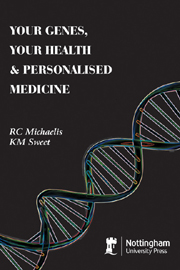Book contents
- Frontmatter
- Contents
- INTRODUCTION
- 1 UNDERSTANDING THE MEANS BY WHICH OUR GENES INFLUENCE OUR HEALTH
- 2 THE MECHANISM WHEREBY A GENE MAKES ITS PROTEIN
- 3 UNDERSTANDING THE PRINCIPLES OF INHERITANCE
- 4 USING YOUR FAMILY HISTORY INFORMATION TO PREDICT YOUR RISK FOR SPECIFIC DISEASES
- 5 USING GENETIC TESTING TO MAINTAIN YOUR HEALTH AND PERSONALISE YOUR MEDICAL CARE, NOW AND IN THE FUTURE
- 6 MAKING THE DECISION WHETHER OR NOT TO HAVE GENETIC TESTING, AND INTERPRETING THE RESULTS OF TESTS YOU CHOOSE TO HAVE PERFORMED
- 7 NUTRIGENOMICS AND EPIGENETICS: THE EFFECTS OUR DIET, ENVIRONMENT AND LIFESTYLE HAVE ON OUR GENES AND PROTEINS
- EPILOGUE AND USEFUL INTERNET RESOURCES
- INDEX
7 - NUTRIGENOMICS AND EPIGENETICS: THE EFFECTS OUR DIET, ENVIRONMENT AND LIFESTYLE HAVE ON OUR GENES AND PROTEINS
- Frontmatter
- Contents
- INTRODUCTION
- 1 UNDERSTANDING THE MEANS BY WHICH OUR GENES INFLUENCE OUR HEALTH
- 2 THE MECHANISM WHEREBY A GENE MAKES ITS PROTEIN
- 3 UNDERSTANDING THE PRINCIPLES OF INHERITANCE
- 4 USING YOUR FAMILY HISTORY INFORMATION TO PREDICT YOUR RISK FOR SPECIFIC DISEASES
- 5 USING GENETIC TESTING TO MAINTAIN YOUR HEALTH AND PERSONALISE YOUR MEDICAL CARE, NOW AND IN THE FUTURE
- 6 MAKING THE DECISION WHETHER OR NOT TO HAVE GENETIC TESTING, AND INTERPRETING THE RESULTS OF TESTS YOU CHOOSE TO HAVE PERFORMED
- 7 NUTRIGENOMICS AND EPIGENETICS: THE EFFECTS OUR DIET, ENVIRONMENT AND LIFESTYLE HAVE ON OUR GENES AND PROTEINS
- EPILOGUE AND USEFUL INTERNET RESOURCES
- INDEX
Summary
What You Eat Affects The Level Of Activity In Some Of Your Genes And Proteins
Most people would agree that good nutrition helps keep us healthy. In fact, Hippocrates himself proposed that good nutrition could serve as a substitute for medicine for maintaining one's health. As the focus of personalised medicine has expanded from genetics to genomics in the last decade, it has become more apparent that the foods we eat can affect the level of activity in our genes and our proteins in ways that influence our risks of developing specific diseases.
For example, one reason why your diet should contain a high level of antioxidants is that your metabolism and other factors, such as smoking, cause your body to produce harmful chemicals called superoxide radicals. These chemicals damage tissues, and are thought to contribute to a number of multifactorial diseases. Your body has several proteins that break down these superoxide radicals and prevent them from damaging your tissues, including one protein called MnSOD. One reason why selenium is included in many multivitamins is that selenium helps the gene that makes MnSOD work at a higher level of activity. There are several known places in the MnSOD gene where the sequence is known to be variable. People with a low-activity allele of the MnSOD gene may need to be especially careful to consume an appropriate amount of selenium, to avoid a further increase in their risk of developing certain diseases.
- Type
- Chapter
- Information
- Your Genes, Your Health and Personalised Medicine , pp. 133 - 150Publisher: Nottingham University PressPrint publication year: 2011



